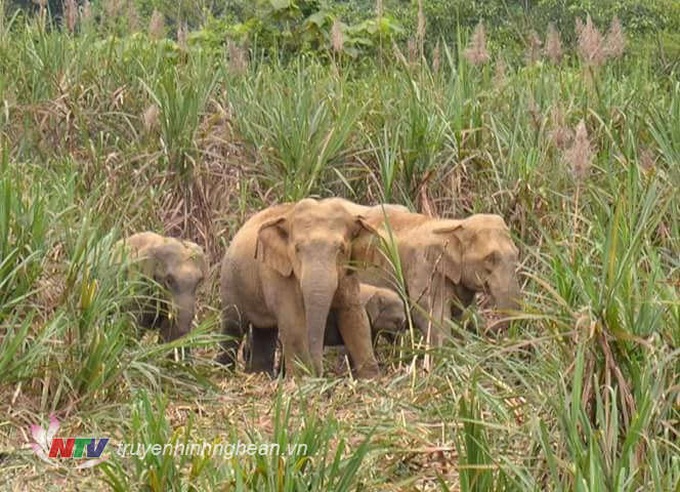
A group of wild elephants from Pu Mat National Forest come to eat sugar cane in Anh Son District, Nghe An Province in March, 2014. Photo by NTV
On November 3, a group of five elephants from Pu Mat National Forest arrived in Bai Da Village in Anh Son District and damaged a cajeput field. Local people have had to hang out lights to the cornfields and around their homes to chase the animals.
"The village is big and the elephants are still coming from other directions," the village's head, Nguyen Van Chau, said. "Elephants often come at the end of the year which is also the harvest season of sugar cane and other crops."
According to a local woman, Pham Thi Hoe, the wild elephants have appeared in his village every year for over the past 10 years and are becoming fiercer.
"Before we only needed the gongs and lights to chase them away," Hoe said. "But now it seems that they are not afraid of such things anymore. They even attack us."
Explaining for the elephants becoming fiercer, director of the Pu Mat National Forest, Tran Xuan Cuong, said that many areas in Anh Son District used to be lush forest which supplied abundant food for the elephants until 2009 when thousands of hectares of forests were cleared and replaced by rubber plantations. The areas for the elephants have been narrowed and food supply have become scarce.
Cuong also recalled that a male elephant was shot dead by an illegal hunter for ivory in 2011 and since then they started to report elephant attacks on local people in their seeking for foods. Two local men were attacked and killed by the elephants in 2011 and 2013.
"We have suggested several measures to avoid the elephant damage to the fields including planting trees that are not elephant food but this is not feasible because sugar cane, corn, banana or cassava are the source of living for local people," Cuong said.
According to local authorities, there are 15 wild elephants in Nghe An Province including four living alone and 11 others living in two herds. The number has not increased over the past seven years. To protect the animal, the government has approved an elephant protection project for 2013-2020 with VND 280 billion. One important target set by the project is to group those living alone into herds.
Although Nghe An is one among three provinces to get funding from the project, local authorities have yet found a solution to move the single elephants into groups. .
"We are thinking of anaesthetising the single elephants while moving it into a group but it may threaten their health and safety because it takes at least two days of travelling on difficult terrain," Cuong explained.
The number of elephants in Vietnam has decreased sharply in recent years due to deforestation and poaching; the total population fell from roughly 1,000 in the mid-1980s to about 120 in 2014, according to official report.
